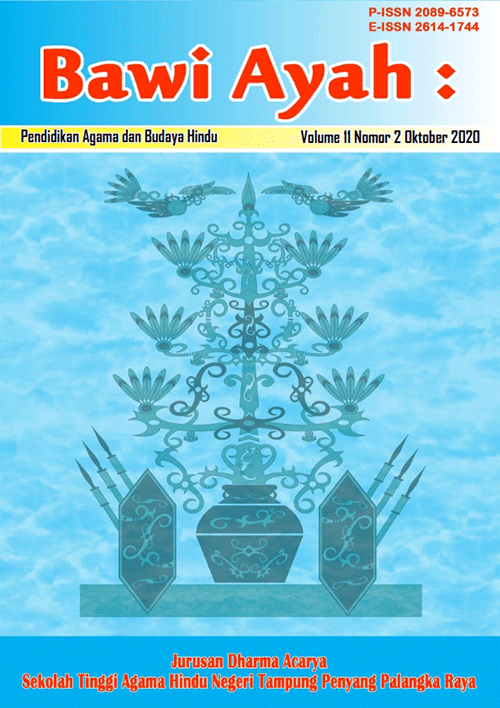KEGIATAN DHARMA YATRA PADA MASYARAKAT DESA LOKAPAKSA KE PURA BATUR
Kajian Pendidikan Agama Hindu
Abstract
The awareness of human life can only be achieved if man can return to his identity as a human being who is an individual creature, a social being and a servant of God and harmonizes each of these relationships so that it continues to be in harmony and balance. In Hinduism this concept is called Tri Hita Karana. In carrying out Dharma yatra activities for the people of Lokapaksa Village to Pura Batur. This is a milestone in the spiritual awakening of Hindus who have long been shackled by customs and culture without being able to understand more deeply about the nature of dharma teachings. This research is in the form of a qualitative design in which data is collected using observation techniques, a way to collect data through direct observation. Data were analyzed using qualitative methods. Based on the analysis, the conclusions from the research results are as follows: The Lokapaksa Village community carries out Dharma Yatra activities, able to form intelligence, namely: intellectual intelligence (IQ). Emotional intelligence (EQ), and spiritual intelligence (SQ). These three intelligences are gifts from God Almighty that must be utilized simultaneously and optimally. In this case, the attitude of the Lokapaksa Village community is able to improve, namely: (1) Attitudes to foster social sensitivity, (2) attitudes to increase self-discipline, (3) reduce materialistic attitudes. Of these three things are the spiritual goals of life to get closer to God and religious practices or religious rituals. The educational values contained in Dharma Yatra activities are: tattwa values, moral values, ceremonial values.
Downloads
References
Hartaka, I. M., & Suadnyana, I. B. P. E. (2020). DHARMA AGAMA DAN DHARMA NEGARA DI ERA KEKINIAN. Pariksa, 2(1).
Kamus besar Bahasa Indonesia . 1989 (Kamus besar Bahasa Indonesia. 1986)
Mas Putra, Ny. I Gst. Agung, dkk. 1995. Upakara Yadnya. Denpasar : IHD.
Oka Punyatmadja, 1976, Sila Krama, Jakarta, Parisadha Hindu Dharma
Pudja, Sudhartha Cok Rai, 2005, Weda Smerti, Paramita Surabaya
Pudja, I Gede. 2004. Bhagawad-Gita. Surabaya : Paramita
Ritzer, G. dan Douglas J. Goodman. 1980. Teori Sosiologi Modern. Edisi Keenam. Jakarta : Kencana.
Suadnyana, I. B. P. E. (2020). Sang Hyang Sambah dalam Ngusabha Sambah di Desa Pakraman Pesedahan, Manggis, Karangasem (Kajian Bentuk Fungsi dan Makna). Sanjiwani: Jurnal Filsafat, 9(1), 87-96.
Suadnyana, I. B. P. E. (2020). Dharma Yudha Karma dalam Kitab Suci Bhagavadgita. Sanjiwani: Jurnal Filsafat, 10(2), 119-134.
Sura, I Gede, 1999. Pengendalian Diri Dan Etika Dalam Ajaran Agama Hindu, Denpasar : Hanuman Sakti.
Salim, Agus. 2001. Teori dan Paradigma Penelitian Sosial ( dari Denzin Guba dan Penerapannya) Yogyakarta : PT. Tiara Wacana.
Titib, I Made, 2003. Purana. (sumber Ajaran Hindu Komperhensip). Jakarta: Pustaka mitra jaya.
Titib I Made, 1998, Weda Pedoman Praktis Kehidupan sehari-hari Paramita Surabaya
Wiana (1997) dalam bukunya yang berjudul Tri Hita Karana menurut konsep Hindu Pt: paramita Denpasar.
Wijayananda, Ida Padanda Mpu Jaya. 2004. Makna Filosofis Upacara dan Upakara. Surabaya : Paramita

This work is licensed under a Creative Commons Attribution 4.0 International License.












